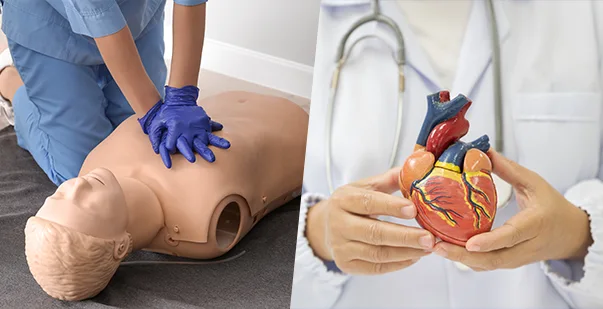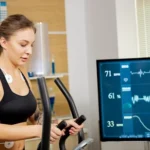Table of Content
- Introduction
- What’s the Difference Between BLS and Heartsaver Instructors?
- Difference Between Heartsaver and BLS
- BLS Courses: For Healthcare Providers
- Heartsaver Courses: For Everyone Else
- Choose the Go-To Training Site
- BLS vs Heartsaver: What’s the Difference in Program and Training?
- Who Should Choose BLS Certification?
- Who Should Get Heartsaver Certified?
- Final Verdict on BLS and Heartsaver Certification
In an emergency, being able to do CPR can save a life. It doesn’t matter if it’s a sudden heart problem at home or in a public place – knowing what to do is the key. But the sad part is only 2.5% of the population gets training every year. Also, not all training centers provide quality courses. So, there is a shortage of professionals in these fields.
Therefore, it’s important to find a well-known place that offers Heartsaver CPR training for different groups of people. This article looks at CPR training and compares two types of courses: Basic Life Support (BLS) and Heartsaver. It also explores Heartsaver vs BLS and when to use each. Let’s check each one, including who they’re for and what skills you’ll learn.
Who are BLS and Heartsaver Instructors?
With so many medical certifications available, choosing the right one can be confusing. Each one has its requirements and curriculum. CPR, AED, BLS, and Heartsaver courses are the demand of the hour, and so are the instructors for them. Let us look at the key differences between BLS and heartsaver instructors:
Who is a BLS Instructor?
BLS stands for Basic Life Support, which is suitable for healthcare workers like nurses, EMTs, and others in the medical field. This cеrtification is also mеant for pеoplе who arе still in mеdical training. The course teaches how to do CPR and how to use an Automated External Defibrillator (AED) on adults, children, and babies.
Requirements
You don’t need to be a medical еxpеrt to become a BLS instructor. Howеvеr, BLS instructors rеcеivе top-notch training, making thеm qualifiеd to teach various coursеs. To become a BLS instructor:
- You need an updated BLS Provider certification card
- You must complete the BLS Instructor Essentials Online training
- You should attend a BLS instructor course
- Someone should monitor you when you are teaching your first class
To complete the instructor training, you’ll also need these course materials:
- BLS Provider Instructor Manual
- BLS Provider Student Manual
- BLS Provider Course Video
If you wish to teach Heartsaver CPR and First Aid programs, you’ll also need the course materials for that course.
After finishing your BLS instructor course, you’ll receive a two-year-valid certification card. This certification also works as a provider certification if you need it for your job.
The cost of a BLS instructor course varies. To keep your certification, you’ll need to teach at least 4 classes in 2 years and have your training center monitor you teaching a course.
Also Read: Cardioversion and defibrillation Overview
Who Is a Heartsaver Instructor?
The Heartsaver course and CPR guidelines are similar to those of a BLS course. However, it doesn’t cover advanced team skills that healthcare workers may use.
Requirements:
What is a Heartsaver certification instructor course? To teach individuals interested in learning about situations where they can help others deal with heart-related emergencies, Heartsaver instructors need to take a special course. Therefore, to become a Heartsaver instructor:
- You should have a current Heartsaver Adult, Child, Infant CPR, and First Aid certification card (make sure it includes First Aid).
- You must complete the online Heartsaver Instructor Essentials course.
- You need to attend a Heartsaver instructor course.
- Someone should monitor you when you are teaching your first class.
You’ll also need these course materials:
- Heartsaver First Aid CPR/AED Instructor Manual.
- Heartsaver First Aid CPR/AED Course Video.
- Heartsaver First Aid CPR/AED Student Manual.
After finishing the course, you’ll get an instructor certification card that’s valid for two years.
The cost of Heartsaver Instructor courses depends on various factors, such as your location, the learning model (in-person vs. online), and the training provider.
Cost of the Course
The cost of Heartsaver Instructor courses depends on various factors, such as your location, the learning model (in-person vs. online), and the training provider. To keep your instructor certification, you need to teach at least four classes in two years and let someone watch you teach one of them. If not, you can take another instructor course to renew your certification.
Difference Between Heartsaver and BLS
Since heartsaver and BLS instructor courses have similar content and CPR guidelines, many people would think – is heartsaver the same as BLS? However, they aren’t the same. The courses are designed for different target audiences based on their professions. The table below shows the difference between heartSaver and BLS instructors:
| Points | BLS | Heartsaver |
| Target Audience | BLS is for healthcare people | HeartSaver is for others who need certification for their jobs |
| Rescuers involved | BLS is about working in teams to save lives, and it covers two-person rescue | HeartSaver is for one person saving lives in a community |
| First Aid module inclusion | BLS only teaches CPR | HeartSaver has a First Aid module if you want it |
| Scope | BLS goes deeper, teaching breathing rescue, advanced airways, and using a special mask device | HeartSaver doesn’t cover these. It encompasses CPR and First aid. |
Choose the Go-To Training Site
You should pick a reliable training site that offers top-notch CPR education. Look for a center that you can trust on several points.
- Remember that convenience matters. That’s why you must choose training sites in easy-to-reach locations and flexible scheduling to fit your busy lifestyle.
- Expert instructors have real-world experience and are passionate about teaching. They make sure you get the best learning experience possible. So, choose a center that has highly qualified instructors.
- You must feel comfortable while learning life-saving skills. The training site must be convenient and hands-on. So you can practice CPR techniques with confidence.
Also Read: How To Get BLS Certification?
BLS vs Heartsaver: What’s the Difference in Program and Training?
BLS is for healthcare workers, teaching them advanced skills for specific medical situations. Heartsaver, on the other hand, is for the general public, focusing on a range of skills for everyday emergencies.
CPR Techniques and Detail
BLS training focuses on advanced CPR techniques, like correctly performing chest compressions and managing airways. Heartsaver, on the other hand, teaches basic CPR to non-medical people, intending to keep blood flowing until help arrives.
Using Automated External Defibrillators (AEDs)
Both BLS and Heartsaver courses teach how to use AEDs. However, BLS provides healthcare providers with more detailed training. This includes advanced techniques, an in-depth understanding of cardiac rhythms, and integration of AED use with other medical interventions tailored to professional healthcare settings.
First Aid and Medical Emergency Response
Heartsaver courses focus on first aid skills such as CPR and others so that you can handle different medical emergencies, not just heart problems. BLS (Basic Life Support) courses, while including some first aid, focus on advanced life-saving techniques for healthcare professionals. BLS training covers more complex procedures and is tailored for medical settings, requiring a higher level of skill and knowledge.
Certification Process for BLS Courses
Signing up for a BLS course is easy. However, you must be prepared to do well in the certification. The certification process involves two main components: a skills test and a written exam. To become certified, you must demonstrate proficiency in practical skills such as CPR and rescue techniques.
Besides, you need to show a thorough understanding of BLS principles and protocols through the written exam. Proper preparation includes:
- Studying course materials.
- Practicing hands-on skills.
- Review common emergency scenarios to ensure you’re ready for both aspects of the certification.
Certification Process for Heartsaver Courses
To get certified in Heartsaver, you’ll follow a process similar to BLS certification. Here’s what you need to do:
- Register for a Heartsaver course
- Understand the course requirements
- Study with recommended materials
- Know what to expect during the training
- Pass a practical skill assessment and a written exam.
These steps ensure you gain a thorough understanding of CPR and first aid skills. The process is similar to BLS certification but focuses on basic life-saving techniques for non-healthcare professionals. Successful completion demonstrates your ability to respond effectively in various medical emergencies.
Who Should Choose BLS Certification?
BLS certification is perfect for doctors, nurses, and emergency medical personnel because they need it for their jobs. Having a valid BLS certification can help them get better job opportunities and do their jobs well in hospitals and clinics.
Healthcare professionals deal with very serious medical situations every day. They need advanced CPR skills to handle these situations. BLS training teaches them how to handle emergencies like heart and breathing problems. It goes beyond basic CPR and prepares them for special situations they might face at work.
Who Should Get Heartsaver Certified?
Heartsaver certification is for everyone, including teachers, parents, and individuals without a medical background. This training teaches essential lifesaving skills for everyday emergencies, making it perfect for non-medical professionals who want to be prepared.
By getting certified, you’ll learn how to respond to emergencies and take action during a cardiac crisis. This training gives you the confidence to save lives!
Importance of BLS and Heartsaver Certification
BLS and Heartsaver certifications are designed to help you respond quickly and effectively in emergencies. With these certifications, you’ll feel confident and stay calm in critical situations and contribute to saving a life during an emergency.
If you’re looking for CPR training, it’s essential to know the difference between BLS and Heartsaver courses. Both courses empower you to respond well in emergencies, no matter if you’re a healthcare pro or just someone who wants to help. Choose the course that’s right for you as an instructor and start your journey to learn lifesaving skills that matter.
Final Verdict on BLS and Heartsaver Certification
Getting a certification to become Heartsaver vs. BLS instructors is a way for healthcare professionals to gain knowledge and experience so that they can teach complex protocols and scenarios to the general public. BLS instructors gain a deeper understanding of life-saving skills as they teach them to healthcare professionals to be ready for emergencies. HeartSaver instructors, on the other hand, teach the general public and those who don’t work in the field of healthcare how to save lives in emergencies.
Heartsaver instructors adjust their teaching to fit different learning styles, helping people feel confident and act fast in emergencies. Both Heartsaver and BLS instructors are important in creating a safe and prepared community in their special ways for their specific groups. Now that you know the key differences between the courses, it’s time to choose the right one and be prepared to save lives in emergencies.






